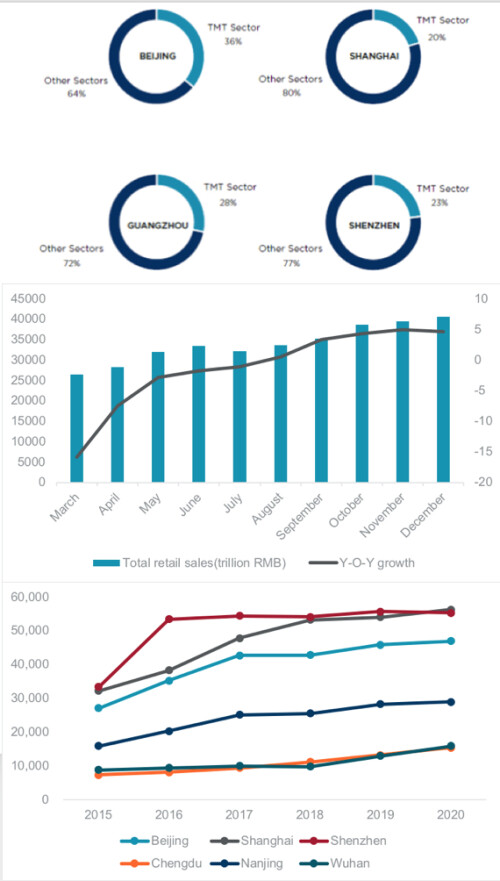Cushman & Wakefield Releases Interpretation of Real Estate Policies in the 2021 China Government Work Report
Government Work Report to Promote the Steady Development of Real Estate Market
BEIJING, CHINA - Media OutReach - 23 March 2021 - Cushman & Wakefield (NYSE: CWK), a leading global real estate services firm today released their China's Two Sessions 2021: Interpretation of Real Estate Policies in the 2021 Government Work Report paper. Sabrina Wei, Chief Policy Analyst, Cushman & Wakefield, pointed out that key policies in the 2021 Government Work Report will promote the sustained development of the office, retail, logistics and residential markets in China, and help stabilize land prices, housing prices and market expectations from both the supply and demand sides.

Figure 4. Total retail sales of consumer goods in 2020
Figure 6: Residential price trends in major cities, 2015 to 2020 (RMB / sq m)
The TMT industry can be expected to continue to be a backbone of the office leasing market into the future.
The government's policy support in the fields of science and technology innovation will certainly help drive the development of the office market. Since its accession to the WTO, China has continuously expanded its investment into technology R&D. Data from the National Bureau of Statistics show that China's expenditure on research and development in 2019 reached RMB2.21 trillion, 3.8 times that of 2009 and 17 times the investment in 2002. In 2020, the number of patent applications from China at the World Intellectual Property Organization numbered 68,720, despite the COVID-19 pandemic, making China the world's leader for patent applications for two consecutive years.
In Tier 1 cities, the TMT industry has played a central role in the office leasing market over the past five years, with the TMT industry's share of office leasing in Beijing, Shanghai, Guangzhou and Shenzhen in 2016-2020 reaching 36%, 20.3%, 28.3% and 23% respectively. With the continued implementation of policies encouraging research and innovation, the TMT industry can be expected to continue to be a backbone of the office leasing market into the future.
The retail sector will witness a strong rebound and emerging retail property development opportunities.
Integrating the strategy of expanding domestic demand with deepening the supply-side structural reform will promote the development of commercial real estate. The supply-side reform policies implemented in the 13th Five-Year Plan period have achieved their key objectives. The measures of "cutting overcapacity, destocking, deleveraging, reducing costs and improving weak links" have effectively cut excessive production capacities and stocks and diminished enterprise debt.
After the adjustments made in the five years during the 13th Five-Year Plan period, the serious mismatch between consumer demands and market supply was greatly improved. Of the development goals for 2021, "Adhering to the strategic base point of expanding domestic demand and fully exploring the potential of the domestic market" is an important factor towards realizing the economic dual circulation model first introduced by President Xi Jinping. Total retail sales of consumer goods fell significantly in 2020 due to the impact of COVID-19. However, as the pandemic gradually came under control domestically retail sales recovered somewhat, with y-o-y growth returning to positive territory in August 2020 and reaching 4.6% y-o-y by the end of 2020 (Figure 4).
With the pandemic effectively controlled domestically the retail sector is now expected to see a strong rebound in 2021, accompanied by development opportunities for the retail property market. Mall landlords took the opportunity presented by the spike in vacancy during the pandemic period to adjust and upgrade brand mixes and positioning, and sectors such as luxury goods, new energy vehicles, "Guochao" trend homegrown brands (an emerging retail influence incorporating aspects of Chinese style, culture and nostalgia into product design) and on-trend F&B can be expected to demonstrate strong growth in the post-pandemic period, in turn boosting business development opportunities for retail projects.
The development of cross-border e-commerce will drive the development of logistics properties.
Data from the United Nations Conference on Trade and Development (UNCTAD) shows that China's cross-border B2C sales reached US$79 billion in 2017, ranking second after the United States worldwide. However, this figure accounted for just 3.5% of total exports and 7.5% of B2C sales, lower than the global average of 10.7%.
The government work report for 2021 highlights the development of cross-border e-commerce, aiming to realize a high-quality import and export structure, further expand consumption, promote the development and upgrading of an open economy, and create new economic growth points. The development of cross-border e-commerce will undoubtedly boost demand for logistics properties, in turn promoting the development of the industrial and logistics real estate market, especially in regions where import and export trade is the main economic driver.
Table 1. Ranking of global cross-border B2C e-commerce sales
|
Ranking |
Country/region |
Cross-border B2C sales (100 million US dollars) |
Proportion of total export (%) |
Proportion of B2C sales (%) |
|
1 |
United States |
1,020 |
6.6 |
13.5 |
|
2 |
China |
790 |
3.5 |
7.5 |
|
3 |
United Kingdom |
310 |
7.0 |
15 |
|
4 |
Japan |
180 |
2.6 |
12.2 |
|
5 |
Germany |
150 |
1.0 |
17.1 |
|
6 |
France |
100 |
1.8 |
10.6 |
|
7 |
Canada |
80 |
1.8 |
12.7 |
|
8 |
Italy |
40 |
0.7 |
16.2 |
|
9 |
South Korea |
30 |
0.5 |
3.8 |
|
10 |
Netherlands |
10 |
0.2 |
5 |
|
Sum of the top 10 |
270 |
3.0 |
10.7 |
|
|
Global |
412 |
2.3 |
10.7 |
|
Source: UNCTAD
Continued urbanization will benefit the regional retail property market.
Urbanization will continue to serve as an important driver of stable and long-term economic development in China.The urbanization rate surpassed the 60% milestone in 2019 to reach 60.6%. In the past decade, an average of 17.86 million people has moved from rural areas into China's cities every year.
The 14th Five-Year Plan does point to an adjustment in strategy, with a lower rate of continuing urbanization to prevail. However, there is still considerable room for growth to achieve the eventual target of a stable urbanization rate of 70%. A likely scenario could still see 16 million people moving to cities every year. Under this premise, city renewal and the planned implementation of inter-provincial urban agglomerations and city clusters will be a key development trend. For the real estate market, the continuing movement of rural populations into cities will increase housing demand and stimulate consumption, in turn benefiting the regional retail real estate market.
For the first time, the government work report proposes to help resolve housing problems experienced by new urban registered citizens and young people in big cities, where subsidized accommodation and homes with common property rights will become the key development initiative. Sustained high residential prices in Tier 1 cities have seriously eroded residents' spending power or opportunities for business startups. High accommodation costs have specifically impacted new urban residents and younger age groups, diminishing their overall quality of life. In contrast, emerging Tier 2 cities have been becoming increasingly attractive to new college graduates and young talent in recent years, drawn by stable housing prices and lower living costs. In 2020, new home prices in Chengdu and Wuhan were less than 30% of those in Shanghai and Shenzhen. Prices in Nanjing were around 50% of those in Shanghai and Shenzhen (Figure 6). In order to tackle the housing problem faced by new urban citizens and young people in big cities, the government is expected to supply more leasable housing in areas where demand is concentrated. The development of the leasing market is expected to focus more on the expansion of accommodation available for long-term leasing, with the government implementing supportive fiscal and financial policies.
Sabrina Wei, Chief Policy Analyst of Cushman & Wakefield said: "Twenty twenty-one is the first year of the 14th Five-Year Plan, and it is also when the foundations for China's economic and social development for the next five years will be laid. The key policies in the Plan will be implemented this year, with the roll-out of measures and actions gradually commencing. We expect that the central objectives of the Plan – strengthening science and technology sectors, fully exploring the consumption potential of the domestic market, developing cross-border e-commerce, maintaining the principle that homes are not for speculation, developing the long-term housing leasing market, and effectively addressing the accommodation needs of new urban residents and young people – will significantly influence the sustained development of the office, retail, logistics and residential markets in China."
Please click here to download the report
About Cushman & Wakefield
Cushman & Wakefield (NYSE: CWK) is a leading global real estate services firm that delivers exceptional value for real estate occupiers and owners. Cushman & Wakefield is among the largest real estate services firms with approximately 53,000 employees in 400 offices and 60 countries. Across Greater China, 22 offices are servicing the local market. The company won four of the top awards in the Euromoney Survey 2017, 2018 and 2020 in the categories of Overall, Agency Letting/Sales, Valuation and Research in China. In 2019, the firm had revenue of $ 8.8 billion across core services of property, facilities and project management, leasing, capital markets, valuation and other services. To learn more, visit www.cushmanwakefield.com or follow @CushWake on Twitter.



